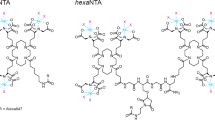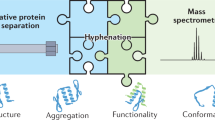Abstract
Electrophoretic mobility shift assays (EMSAs) are commonly used to analyze nucleic acid–protein interactions. When nucleic acid is bound by protein, its mobility during gel electrophoresis is reduced. Similarly, the final position of protein within a complex is shifted when compared to its free state. Here we provide a protocol for a simple approach that uses these mobility differences to identify nucleic acid-binding proteins. Following EMSA, denaturing gel electrophoresis is implemented to provide a second dimension of separation. Protein that binds a specific nucleic acid is identified as a spot(s) whose presence at a particular position(s) is dependent on nucleic acid within the initial binding reaction. The polypeptide in a spot can be subsequently identified by mass spectrometry. As EMSAs can be performed using partially purified or cell extracts, this approach substantially reduces the need for protein purification. It should facilitate the identification of a nucleic acid-binding protein within approximately 4 d.
This is a preview of subscription content, access via your institution
Access options
Subscribe to this journal
Receive 12 print issues and online access
$259.00 per year
only $21.58 per issue
Buy this article
- Purchase on Springer Link
- Instant access to full article PDF
Prices may be subject to local taxes which are calculated during checkout







Similar content being viewed by others
References
Fried, M. & Crothers, D.M. Equilibria and kinetics of Lac repressor-operator interactions by polyacrylamide gel electrophoresis. Nucleic Acids Res. 9, 6505–6525 (1981).
Garner, M.M. & Revzin, A. A gel-electrophoresis method for quantifying the binding of proteins to specific DNA regions: application to components of the Escherichia coli lactose operon regulatory system. Nucleic Acids Res. 9, 3047–3060 (1981).
Fried, M.G. Measurement of protein-DNA interaction parameters by electrophoresis mobility shift assay. Electrophoresis 10, 366–376 (1989).
Garner, M.M. & Revzin, A. The use of gel-electrophoresis to detect and study nucleic acid-protein interactions. Trends Biochem. Sci. 11, 395–396 (1986).
Fried, M.G. & Crothers, D.M. Equilibrium studies of the cyclic-AMP receptor protein-DNA interaction. J. Mol. Biol. 172, 241–262 (1984).
Lohman, T.M., Dehaseth, P.L. & Record, M.T. Pentalysine-deoxyribonucleic acid interactions: a model for the general effects of ion concentrations on the interactions of proteins with nucleic acids. Biochemistry 19, 3522–3530 (1980).
Lohman, T.M., DeHaseth, P.L. & Record, M.T. Analysis of ion concentration effects on kinetics of protein-nucleic acid interactions. Application to Lac repressor-operator interactions. Biophys. Chem. 8, 281–294 (1978).
Fried, M.G. & Crothers, D.M. Kinetics and mechanism in the reaction of gene regulatory proteins with DNA. J. Mol. Biol. 172, 263–282 (1984).
Gadgil, H., Jurado, L.A. & Jarrett, H.W. DNA affinity chromatography of transcription factors. Anal. Biochem. 290, 147–178 (2001).
Moxley, R.A., Jarrett, H.W. & Mitra, S. Methods for transcription factor separation. J. Chromatogr. B Analyt. Technol. Biomed. Life Sci. 797, 269–288 (2003).
Pinolroma, S., Choi, Y.D. & Dreyfuss, G. Immunological methods for purification and characterization of heterogeneous nuclear ribonucleoprotein-particles. Methods Enzymol. 181, 317–325 (1990).
Nordhoff, E. et al. Rapid identification of DNA-binding proteins by mass spectrometry. Nat. Biotechnol. 17, 884–888 (1999).
Yaneva, M. & Tempst, P. Affinity capture of specific DNA-binding proteins for mass spectrometric identification. Anal. Chem. 75, 6437–6448 (2003).
Woo, A.J., Dods, J.S., Susanto, E., Ulgiati, D. & Abraham, L.J. A proteomics approach for the identification of DNA binding activities observed in the electrophoretic mobility shift assay. Mol. Cell. Proteomics 1, 472–478 (2002).
Stead, J.A., Keen, J.N. & McDowall, K.J. The identification of nucleic acid-interacting proteins using a simple proteomics-based approach that directly incorporates the electrophoretic mobility shift assay. Mol. Cell. Proteomics 5, 1697–1702 (2006).
Hope, I.A. & Struhl, K. Functional dissection of a eukaryotic transcriptional activator protein, GCN4 of yeast. Cell 46, 885–894 (1986).
Bremer, H. & Dennis, P. Modulation of chemical composition and other parameters of the cell by growth rate. in Escherichia coli and Salmonella: Cellular and Molecular Biology (ed. Neidhardt, F.C.) 1553–1569 (ASM Press, Washington D.C., 1996).
Sherman, F. Getting started with yeast. in Guide to Yeast Genetics and Molecular and Cell Biology, Part B (eds. Guthrie, C. and Fink, G.R.) 3–41 (Academic Press, San Diego, 2002).
Jackson, S.P. & Tjian, R. Purification and analysis of RNA polymerase II transcription factors by using wheat germ-agglutinin affinity chromatography. Proc. Natl. Acad. Sci. USA 86, 1781–1785 (1989).
Ghaemmaghami, S. et al. Global analysis of protein expression in yeast. Nature 425, 737–741 (2003).
Uguru, G.C. et al. Transcriptional activation of the pathway-specific regulator of the actinorhodin biosynthetic genes in Streptomyces coelicolor. Mol. Microbiol. 58, 131–150 (2005).
Allen, S.V. & Miller, E.S. RNA-binding properties of in vitro expressed histidine-tagged RB69 RegA translational repressor protein. Anal. Biochem. 269, 32–37 (1999).
Callaghan, A.J. et al. Structure of Escherichia coli RNase E catalytic domain and implications for RNA turnover. Nature 437, 1187–1191 (2005).
Jiao, X., Trifillis, P. & Kiledjian, M. Identification of target messenger RNA substrates for the murine deleted in azoospermia-like RNA-binding protein. Biol. Reprod. 66, 475–485 (2002).
Kaberdin, V.R., Chao, Y.H. & Sue, L.C. RNase E cleaves at multiple sites in bubble regions of RNA I stem loops yielding products that dissociate differentially from the enzyme. J. Biol. Chem. 271, 13103–13109 (1996).
Sengupta, T.K., Gordon, J. & Spicer, E.K. RegA proteins from phage T4 and RB69 have conserved helix-loop groove RNA binding motifs but different RNA binding specificities. Nucleic Acids Res. 29, 1175–1184 (2001).
Ta, M. & Vrati, S. Mov34 protein from mouse brain interacts with the 3 noncoding region of Japanese encephalitis virus. J. Virol. 74, 5108–5115 (2000).
Grunwald, M.E., Yu, W.P., Yu, H.H. & Yau, K.W. Identification of a domain on the beta-subunit of the rod cGMP-gated cation channel that mediates inhibition by calcium-calmodulin. J. Biol. Chem. 273, 9148–9157 (1998).
Dangerfield, J.A., Windbichler, N., Salmons, B., Gunzburg, W.H. & Schroder, R. Enhancement of the StreptoTag method for isolation of endogenously expressed proteins with complex RNA binding targets. Electrophoresis 27, 1874–1877 (2006).
Bachler, M., Schroeder, R. & von Ahsen, U. StreptoTag: a novel method for the isolation of RNA-binding proteins. RNA 5, 1509–1516 (1999).
Moxley, R.A. & Jarrett, H.W. Oligonucleotide trapping method for transcription factor purification systematic optimization using electrophoretic mobility shift assay. J. Chromatogr. A 1070, 23–34 (2005).
Gadgil, H. & Jarrett, H.W. Oligonucleotide trapping method for purification of transcription factors. J. Chromatogr. A 966, 99–110 (2002).
Buratowski, S. & Chodosh, L.A. Mobility shift DNA-binding assay using gel electrophoresis. in Current Protocols in Molecular Biology (eds. Ausubel, F.M. et al.) 12.12.11–12.12.11 (John Wiley and Sons, New York, 1996).
Lane, D., Prentki, P. & Chandler, M. Use of gel retardation to analyze protein-nucleic acid interactions. Microbiol. Rev. 56, 509–528 (1992).
Fried, M.G. & Garner, M.M. The electrophoretic mobility shift assay (EMSA) for detection and analysis of protein-DNA interactions. in Molecular Biology Methods and Applications (ed. Tietz, D.) 239–271 (Elsevier, New York, 1998).
Carey, J. Gel retardation. Methods Enzymol. 208, 103–117 (1991).
Hellman, L.M. & Fried, M. Electrophoretic mobility shift assay (EMSA) for protein-nucleic acid interaction. Nat. Protoc. 2, 1849–1861 (2007).
Li, Y., Jiang, Z.Z., Chen, H.X. & Ma, W.J. A modified quantitative EMSA and its application in the study of RNA-protein interactions. J. Biochem. Biophys. Methods 60, 85–96 (2004).
Kang, J., Lee, M.S. & Gorenstein, D.G. Quantitative analysis of chemiluminescence signals using a cooled charge-coupled device camera. Anal. Biochem. 345, 66–71 (2005).
Forwood, J.K. & Jans, D.A. Quantitative analysis of DNA-protein interactions using double-labeled native gel electrophoresis and fluorescence-based imaging. Electrophoresis 27, 3166–3170 (2006).
Jing, D., Agnew, J., Patton, W.F., Hendrickson, J. & Beechem, J.M. A sensitive two-color electrophoretic mobility shift assay for detecting both nucleic acids and protein in gels. Proteomics 3, 1172–1180 (2003).
Vossen, K.M., Wolz, R., Daugherty, M.A. & Fried, M.G. Role of macromolecular hydration in the binding of the Escherichia coli cyclic AMP receptor to DNA. Biochemistry 36, 11640–11647 (1997).
Garner, M.M. & Rau, D.C. Water release associated with specific binding of gal repressor. EMBO J. 14, 1257–1263 (1995).
Shevchenko, A., Tomas, H., Havlis, J., Olsen, J.V. & Mann, M. In-gel digestion for mass spectrometric characterization of proteins and proteomes. Nat. Protoc. 1, 2856–2860 (2006).
Carrette, O., Burkhard, P., Sanchez, J.-C. & Hochstrasser, D. State-of-the-art two-dimensional gel electrophoresis: a key tool of proteomics research. Nat. Protoc. 1, 812–823 (2006).
Chevallet, M., Luche, S. & Rabilloud, T. Silver staining of proteins in polyacrylamide gels. Nat. Protoc. 1, 1852–1858 (2006).
Havlis, J., Thomas, H., Sebela, M. & Shevchenko, A. Fast-response proteomics by accelerated in-gel digestion of proteins. Anal. Chem. 75, 1300–1306 (2003).
Kaberdin, V.R. & McDowall, K.J. Expanding the use of zymography by the chemical linkage of small, defined substrates to the gel matrix. Genome Res. 13, 1961–1965 (2003).
Acknowledgements
Ph.D. studentship S02/G031 from the UK Biotechnology and Biological Sciences Research Council (BBSRC). Facilities provided by the BBSRC under the JIF (Joint Infrastructure Fund) Initiative. Helpful comments from colleagues Ian Hope, Simon Baumberg (now deceased) and Peter Stockley.
Author information
Authors and Affiliations
Corresponding author
Ethics declarations
Competing interests
The authors declare no competing financial interests.
Rights and permissions
About this article
Cite this article
Stead, J., McDowall, K. Two-dimensional gel electrophoresis for identifying proteins that bind DNA or RNA. Nat Protoc 2, 1839–1848 (2007). https://doi.org/10.1038/nprot.2007.248
Published:
Issue Date:
DOI: https://doi.org/10.1038/nprot.2007.248
This article is cited by
-
Automated microfluidic protein immunoblotting
Nature Protocols (2010)
-
Electrophoretic mobility shift assay (EMSA) for detecting protein–nucleic acid interactions
Nature Protocols (2007)
Comments
By submitting a comment you agree to abide by our Terms and Community Guidelines. If you find something abusive or that does not comply with our terms or guidelines please flag it as inappropriate.



